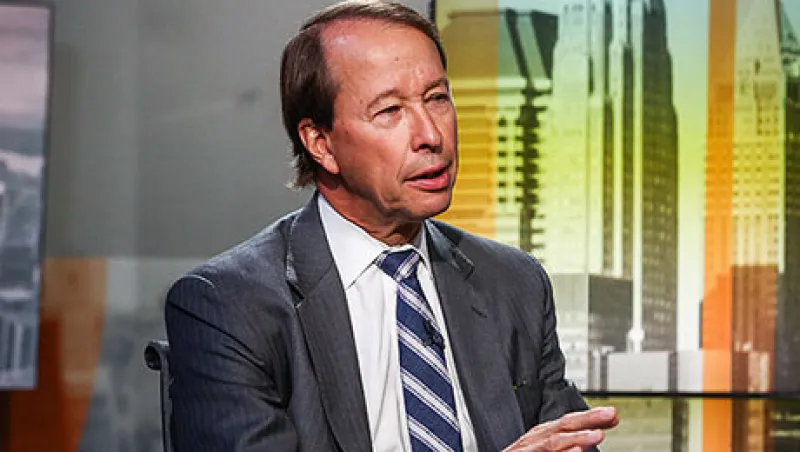A surprising new voice has joined the growing chorus of those worried about a retirement crisis in the U.S. Over the years we’ve heard plenty from policymakers, think-tank denizens, and academics. So Hamilton (Tony) James, president and COO of $311 billion Blackstone Group, is a welcome addition to the debate over how to ensure that millions don’t retire in poverty.
James entered the fray in September with the publication of Rescuing Retirement: A Plan to Guarantee Retirement Security for All Americans. He co-wrote the book with veteran labor economist and retirement security expert Teresa Ghilarducci, the Bernard L. and Irene Schwartz professor of economics at the New School for Social Research and director of the New School’s Schwartz Center for Economic Policy Analysis (SCEPA) and its Retirement Equity Lab (ReLab).
“It’s a huge issue for America, and we need to focus on it,” says James, whom Blackstone co-founder Stephen Schwarzman recruited from Credit Suisse First Boston in 2002 to help grow the private equity and asset management giant. “I wanted to start a national dialogue.”
James had been studying the issues around retirement security in the U.S. for about two years when he reached out to Ghilarducci to see how they might work together to create a new retirement savings structure for the many people who are saving nothing or too little.
As a first step, the pair wrote their book to present the facts and a clear outline of how to solve the problem on a national level. Ghilarducci and James point out that the average retirement savings balance of an American between the ages of 40 and 55 is $14,500, and the median savings in a 401(k) account is $18,433; but to retire comfortably, the average American needs about $375,000. Also, 68 percent of working people (those aged 25 to 64) don’t have a retirement plan because their employer doesn’t offer one, they don’t participate in their workplace plan, or they’re not working.
Ghilarducci and James call for restructuring the 401(k) and IRA system, making the new program mandatory for employers and employees, and including the use of annuities. “Anybody who is not in a defined benefit plan is exposed to a failed system,” Ghilarducci tells Institutional Investor. The proposed system aims to get participants as close as possible to the key benefits of a traditional pension.
Support from the retirement security sector has been encouraging. “It’s a very important contribution to the dialogue,” says Karen Friedman, policy director of the Pension Rights Center, a consumer advocacy group. “It is very well-written, very creative, and a solid solution.”
Friedman cites key ideas such as mandating a retirement savings plan on top of Social Security, having all employers and employees contribute unless they’re already sponsoring or in a plan, and providing a system of adequacy not offered by 401(k) plans.
When it comes to ensuring that a large portion of the 50 million full-time U.S. workers who lack access to a retirement plan or choose not to contribute to one will start saving, not everybody agrees that a new national program is necessary. Josh McGee, a policy expert and economist with the Laura and John Arnold Foundation, which focuses on public pensions, education, and criminal justice, believes the current system of defined contribution plans is working adequately.
“The book dramatically overstates the problem,” says McGee, who is also a senior fellow at the Manhattan Institute, a conservative think tank. “It’s not clear we need a federally mandated system.”
In McGee’s view, “it is a little foolhardy to propose that all we have to do is invest in these pooled funds when so many [retirement] assets are already in target date funds.” However, he does agree that annuitization of defined contribution plan assets has room for improvement.
James and Ghilarducci recently visited members of the U.S. Senate and House of Representatives, including Democratic senators Cory Booker and Ronald Wyden and their Republican counterpart Robert Corker, to introduce the national savings program. “In the government there is recognition we need a federal plan and everybody needs to be in a plan,” Ghilarducci says.
One of the co-authors’ visits was with Representative Joseph Crowley, who has sponsored legislation to create USAccounts, which would give every child an individualized savings vehicle at birth. Crowley also has promoted the creation of workplace savings accounts, based on the federal Thrift Savings Plan, that every employer with more than ten staff would sponsor.
“We’re seeing a new generation of Americans growing up with little or no savings to help them climb the economic ladder, weather a difficult time, or create a comfortable nest egg for their family,” the New York Democrat says. “And that has to change.”
James, a noted philanthropist who serves on the boards of the Center for American Progress, the Metropolitan Museum of Art, the Mount Sinai Health System, and the Wildlife Conservation Society, says he has spoken with labor leaders and the CEOs of major U.S. corporations, finding them unanimous in their praise for his proposed retirement program.
“There used to be a coming together of issues of national importance,” he observes. “We haven’t done this in 50 years.” James believes the time to act is now.






